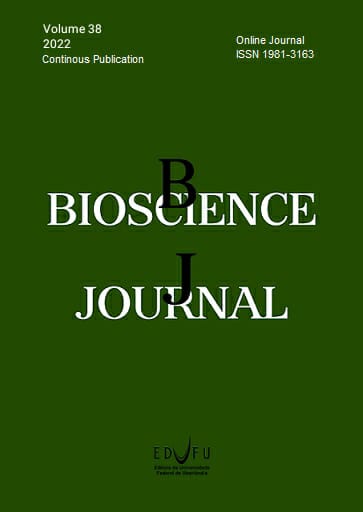Survival capacity of Arcobacter butzleri at different incubation temperatures in drinking water
DOI:
https://doi.org/10.14393/BJ-v38n0a2022-50398Palavras-chave:
Arcobacter butzleri, Drinking water, Survival.Resumo
Arcobacter é um patógeno zoonótico emergente de importância crescente em saúde pública. A água potável tem sido considerada como um importante fator de risco para sua disseminação. O objetivo deste trabalho foi avaliar a capacidade de sobrevivência e crescimento de Arcobacter em diferentes matrizes de água mantidas a diferentes temperaturas. Foram utilizadas três matrizes de água diferentes, sendo água potável com concentração de cloro de 0,5 mg / mL, água não clorada e água não clorada acrescida de 11% de matéria orgânica. Cada matriz foi inoculada em proporção de 1/10 com uma suspensão de um pool de 5 cepas de Arcobacter em concentrações de 103 e 105. As amostras de água foram divididas em 4 sub-amostras diferentes para serem incubadas a 0, 5, 12 e 25 ° C por até 15 dias. Os resultados obtidos mostram que Arcobacter foi capaz de sobreviver em todas as matrizes de água analisadas, independentemente da presença ou não de agente desinfetante residual. Além disso, a quantidade de UFC / mL inoculada na água correlaciona-se com o número de bactérias que podem permanecer viáveis nela, e a temperatura de incubação tem um efeito significativo sobre a sobrevivência bacteriana. Infere-se que a transmissão de A butzleri pode ocorrer pela água potável, a qual poderia ser uma importante fonte de infecção.
Downloads
Referências
ASSANTA, M.A., et al. Attachment of Arcobacter butzleri, a new waterborne pathogen, to water distribution pipe surfaces. Journal of Food Protection. 2002, 65(8), 1240-1247. https://doi.org/10.4315/0362-028X-65.8.1240
BADILLA-RAMÍREZ, Y., et al. Survival capacity of Arcobacter butzleri inoculated in poultry meat at two different refrigeration temperatures. Revista do Instituto de Medicina Tropical. 2016, 58, 22. http://dx.doi.org/10.1590/S1678-9946201658022
BANTING, G. and FIGUERAS SALVAT, M.J., 2017. Arcobacter. In: ROSE, J.B. and JIMÉNEZ-CISNEROS, B. (Eds.). Global Water Pathogen Project. Michigan State University: UNESCO, pp. 1-29.
COLLADO, L. and FIGUERAS, M. Taxonomy, epidemiology, and clinical relevance of the genus Arcobacter. Clinical Microbiology Reviews. 2011, 24(1), 174-192. https://doi.org/10.1128/cmr.00034-10
FERNANDEZ, N., et al. Analysis of microbial community during biofilm development in an anaerobic wastewater treatment reactor. Microbial Ecology. 2008, 56, 121-132. https://doi.org/10.1007/s00248-007-9330-2
GIACOMETTI, F., et al. Arcobacter butzleri, Arcobacter cryaerophilus, and Arcobacter skirrowii circulation in a dairy farm and sources of milk contamination. Applied and Environmental Microbiology. 2015, 81(15), 5055-5063. https://doi.org/10.1128/AEM.01035-15
GIRBAU, C., et al. Study of biofilm formation ability of foodborne Arcobacter butzleri under different conditions. Journal of Food Protection. 2017, 80(5), 758-762. https://doi.org/10.4315/0362-028X.JFP-16-505
JALAVA, K., et al. Novel microbiological and spatial statistical methods to improve strength of epidemiological evidence in a community wide waterborne outbreak. PLoS ONE. 2014, 9(8), e104713. https://doi.org/10.1371/journal.pone.0104713
KJELDGAARD, D.J., JØRGENSEN, K. and INGMER, H. Growth and survival at chiller temperatures of Arcobacter butzleri. International Journal of Food Microbiology. 2009, 131(2-3), 256-259. https://doi.org/10.1016/j.ijfoodmicro.2009.02.017
LAISHRAM, M., et al. Isolation and characterization of Arcobacter spp. from fresh seafood and the aquatic environment. International Journal of Food Microbiology. 2016, 232, 87-89. https://doi.org/10.1016/j.ijfoodmicro.2016.05.018
LEE, C., et al. Arcobacter in Lake Erie beach waters: an emerging gastrointestinal pathogen linked with human-associated fecal contamination. Applied and Environmental Microbiolgy. 2012., 78(16), 5511-5519. https://doi.org/10.1128/AEM.08009-11
MORENO, Y., et al. Survival and injury of Arcobacter after artificial inoculation into drinking water. Research in Microbiology. 2004, 155(9), 726-730. https://doi.org/10.1016/j.resmic.2004.05.011
RICE, E.W., et al. Isolation of Arcobacter butzleri from ground water. Letters in Applied Microbology. 1999, 28(1), 31-35. https://doi.org/10.1046/j.1365-2672.1999.00483.x
SHAH, A.H., et al. Genetic characterization of Arcobacter isolates from various sources. Veterinary Microbiology. 2012, 160(3-4), 355-361. https://doi.org/10.1016/j.vetmic.2012.05.037
VALVERDE BOGANTES, E., et al. Zoonotic species of the genus Arcobacter in poultry from different regions of Costa Rica. Journal of Food Protection. 2015, 78(4), 808–811. https://doi.org/10.4315/0362-028X.JFP-14-494
VILLANUEVA, M., MEDINA, G. and FERNÁNDEZ, H. Arcobacter butzleri survives within trophozoite of Acanthamoeba castellanii. Revista Argentina de Microbiología. 2016, 48(2), 106-109. https://doi.org/10.1016/j.ram.2015.12.003
Downloads
Publicado
Como Citar
Edição
Seção
Licença
Copyright (c) 2022 Ana Laura Rodríguez Hidalgo, María Laura Arias Echandi, Eduardo Castro Arias, Heriberto Fernandez Jaramillo

Este trabalho está licenciado sob uma licença Creative Commons Attribution 4.0 International License.






